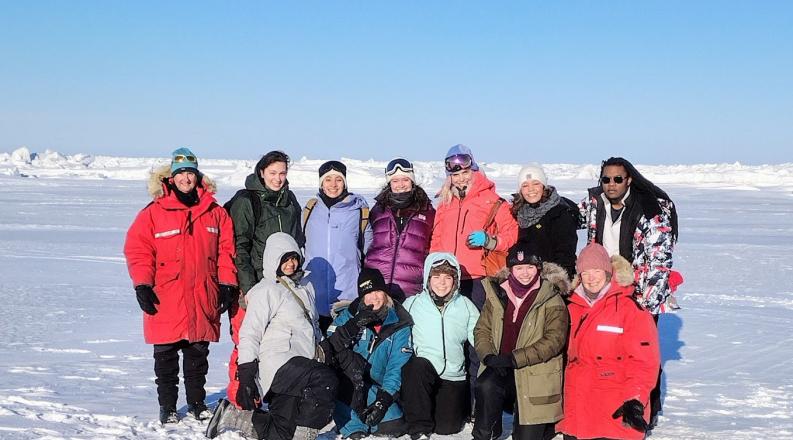By David Simpson and Elizabeth Smith
For college students, a chance to do authentic field work can cement theoretical knowledge, spark the imagination, even reveal a new career path. Old Dominion University offers many such course-based opportunities.
Over spring break, 10 ODU students traveled to northern Alaska with Victoria Hill, an assistant professor of Ocean and Earth Sciences, as part of her Arctic Change class (OEAS 395).
There, they got a firsthand look at being a field scientist who studies the earth. They learned to drill through sea ice to measure its thickness, collected ice and water samples, and analyzed data from the buoys Dr. Hill has released in the Arctic Ocean over the years.
"Very few people get to travel to the Arctic sea ice," Hill said, "and I wanted our students to see and experience it before it becomes even more difficult for them to get to it, due to thinner sea ice and fast seasonal melt."
Her research focuses on how light penetration and the absorption of that light right beneath the sea ice could be critical to improving scientists' understanding of the rapid sea ice melt and retreat in the Arctic.
"What a trip!" wrote Elizabeth Smith, director of interdisciplinary initiatives for the Graduate School, in a diary she kept on Facebook. A marine science researcher herself, she accompanied the group on their Arctic journey to Utqiagvik (formerly Barrow).
On March 7, their first day, the students learned to use the ice auger and common drill, then measured ice thickness in different parts of the pack near the beach.
"We all also figured out how to work in such cold conditions," Smith wrote. "It was sunny and windless, but around 2-3 degrees C. We also met one of our bear guards, Matt. Matt kept an eye out for polar bears, and was keen to know what we were up to. He also found some polar bear tracks and scat! It was a good, good day!"
A few more excerpts from her diary:
March 8: "Dr. Hill is a true champion for science, showing the students how to collect a 2m ice core and do some common sampling. Gloves off and a master with the Leatherman (tool), she quickly and calmly solved problems as they came up, including retrieving an ice core from the hole when it broke off. "
March 9: "Yesterday, after we measured ice thickness, captured some amazing images using the drone, and dropped the GoPro down under the surface of the ice (very, very clear water down there!), we learned that the 'cast-away' instrument that measures salinity and temperature with depth would not turn on. This sometimes happens! We will try again tomorrow."
March 12: "Sunrise over the land-fast ice and snowy tundra on our last morning. No work today but cleaning up Nanuq's Den (our rooms), packing, and saying goodbye. We did spy two bears moving quickly across the ice on our way to see the sunrise, but they ran out of sight fast."
Later, the group settled in for the long flight home, the first leg taking them almost directly over Denali, North America's tallest mountain. After that came stops in Anchorage, Minneapolis, Atlanta and, finally, Norfolk.
For the students, the Arctic adventure held many memorable moments. Here are some of their favorites:
"The comradery that evolved within our awesome group and the opportunity to see two Arctic Circle staples: a wild polar bear and the northern lights!" said Julianne Jones.
Mary LePere: "Taking snow machines out to Point Barrow."
Sofia Baez: "Getting to talk to the bear guards and some of the other locals and learning about what their life is like there."
Hill reflected: "I think that, apart from the science aspect, the students got to see a very different American culture, and there is a certain amount of personal growth and development that comes with a trip with your peers rather than family."
It's clear from the group's experience that field work and undergraduate research can make for a potent learning combination. In fact, just days after the students returned home, they presented four posters at ODU's Undergraduate Research Symposium, held on March 19. The posters are based on buoy data they analyzed.
Poster titles and authors:
"Investigating Light Driven Processes in the Upper Arctic Ocean via an Autonomous Buoy," Sofia Baez, Rachel Bowser, Kate Draa
"Assessing Roles of Temperature and Light Intensity Under Arctic Sea Ice Using an Autonomous Buoy," Hannah Hays, Jordyn Leeper, Julianne Jones
"Analyzing Temperature, Light Intensity, Light Attenuation, and Chlorophyll Under Arctic Sea Ice Using an Autonomous Buoy," Isabel Martinez, Kim Lockwood, Mary LePere
"Assessing the Role of Heat and Light Processes in the Canada Basin With an Autonomous Buoy (WARM Buoy 6)," Kylie Harrison, Cheyenne Goodman, Immanuel Burns.
For a look at this research, Smith's diary and more pictures, visit the Ocean and Earth Sciences Facebook page (March 1-23).



